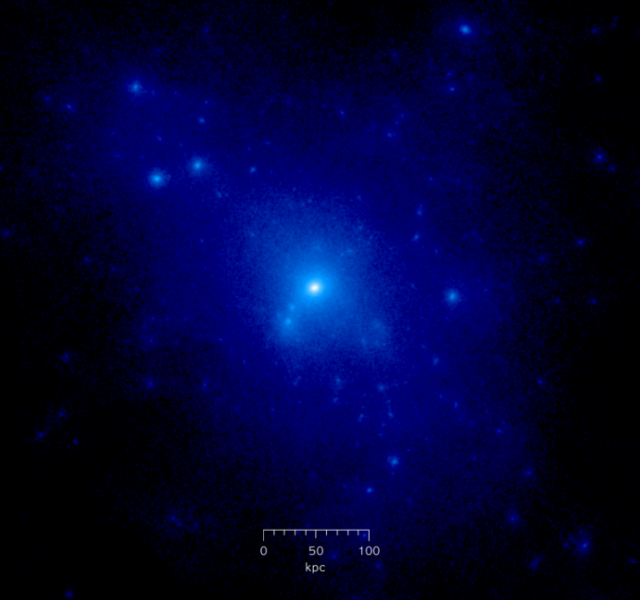Simulating galaxies on computers:
a story of the Universe
across space and time

Dr. Corentin Cadiou
University College London

Credits: NASA & ESA


Sombrero galaxy
M83


"Penguin" galaxy
Magellanic clouds

M87 galaxy
What is a galaxy?
Credits: A. Russell/ESO
What is a galaxy?
Credits: A. Russell/ESO
- Hundreds of billions of stars*
- Dust
- Gas
- Dark matter
- Supermassive black hole
* only true for Milky Way, may vary by order of magnitudes


Dust in the horsehead nebula, credits: HST
Star-forming region (Westerlund 2), credits: HST

SMBH in galaxy M87, credit: EHT

DM (in blue) in a simulation
Credits: Adams Evans
Observations in astronomy
Credits: Adams Evans
Observations in astronomy
Three key issues
- Distances — no parallax



Credits: Adams Evans
Observations in astronomy
Three key issues
- Distances — no parallax
- Times — seemingly no evolution




Credits: Adams Evans
Observations in astronomy
Three key issues
- Distances — no parallax
- Times — seemingly no evolution



Andromeda in 1899 by Isaac Roberts

Credits: Adams Evans
Observations in astronomy
Three key issues
- Distances — no parallax
- Times — seemingly no evolution
- Scale coupling







mm
km
10,000 km
Credits: Adams Evans
Observations in astronomy
Three key issues
- Distances — no parallax
- Times — seemingly no evolution
- Scale coupling







km
10,000 km
\(10^{-3} \ \mathrm{ly} \)
Credits: Adams Evans
Observations in astronomy
Three key issues
- Distances — no parallax
- Times — seemingly no evolution
- Scale coupling







\(10\ \mathrm{ly}\)
10,000 km
\(10^{-3} \ \mathrm{ly} \)
Credits: Adams Evans
Observations in astronomy
Three key issues
- Distances — no parallax
- Times — seemingly no evolution
- Scale coupling







\(10\ \mathrm{ly}\)
\(100,000 \ \mathrm{ly}\)
\(10^{-3} \ \mathrm{ly} \)
NASA; ESA; and F. Summers
Simulations are proxy for experiments
Merging of the Milky Way (our own galaxy)
with Andromeda [in a few billion years]
NASA; ESA; and F. Summers
Simulations are proxy for experiments
NASA; ESA; and F. Summers
How to simulate the Universe?
... and galaxies therein


Each bright dot is one galaxy



?
HST
- Create a box for space and time
- Include known physics
- Set some initial conditions
- Move time forward
- ☕*
-
SCIENCE!
- Compare to observations
- Make predictions
- …
How to simulate the Universe?
... and galaxies therein
* of the order of \( 10^6-10^7\ \mathrm{hr} \approx 100-1000\ \mathrm{yr} \)


- Create a box for space and time
- Include known physics
- Set some initial conditions
- Move time forward
- ☕*
-
SCIENCE!
- Compare to observations
- Make predictions
- …
How to simulate the Universe?
... and galaxies therein
* of the order of \( 10^6-10^7\ \mathrm{hr} \approx 100-1000\ \mathrm{yr} \)


- Create a box for space and time
- Include known physics
- Set some initial conditions
- Move time forward
- ☕
-
SCIENCE !
- Compare to observations
- Make predictions
- …
How to simulate the Universe?
... and galaxies therein

Forming galaxies...
New Horizon simulation — IAP, CNRS


50 million light year
50 million light year
Galaxies
- form in a "cosmic web"
- grow by accreting
- merge together
1 million light year
100,000 light year

We have a scenario for galaxy formation
We have a scenario for galaxy formation
- Formation of dark matter "halos"...
- ... and of the cosmic web
- Gas falls in, galaxies merge
- Gas condenses to form stars & black holes
- Stars & black holes expel gas




3C 348 seen by HST & VLA


Crab nebula seen by HST
We have a scenario for galaxy formation
Can we test it?
Effect of physical parameters
Formation of stars
Formation of black holes
Feedback effects
[...]




Effect of physical parameters






Dubois+16







Black holes prevent the formation
of large spiral galaxies
Effect of physical parameters








Dubois+16



The initial conditions of the Universe
Our whole universe was in a hot, dense state*
Then nearly fourteen billion years ago expansion started, wait […]
*(and homogenous)

The initial conditions of the Universe

Planck satellite. Credits: ESA/NASA/JPL-Caltech
The initial conditions of the Universe

The initial conditions of the Universe

Initial conditions
Evolved Universe (+ galaxies)

The initial conditions of the Universe

Initial conditions
Evolved Universe (+ galaxies)

The Universe is determined
by its initial conditions
Initial conditions = DNA of galaxies
Genetically modified galaxies?
\(14\ \mathrm{Gyr}\)

The initial conditions of the Universe
Initial conditions:
- Tiny density fluctuations \(\sim 0.001\% \)
-
Very well described mathematically*
→ easy to generate
*By a Gaussian random field with known spectrum







The initial conditions of the Universe
Initial conditions:
- Tiny density fluctuations \(\sim 0.001\% \)
-
Very well described mathematically*
→ easy to generate & constrain
"Splicing" method, Cadiou+ in prep.
The initial conditions of the Universe
"Splicing" method, Cadiou+ in prep.


\(14\ \mathrm{Gyr}\)
The initial conditions of the Universe


Galaxies are influenced by a region at least \( 100\times\) larger


"Splicing" method, Cadiou+ in prep.


Galaxies are influenced by a region at least \( 100\times\) larger

"Splicing" method, Cadiou+ in prep.
\(100\ \mathrm{kly}\)
\(10 \ \mathrm{Mly}\)

We can simulate galaxies on (super)computers
→ insight on actual galaxies
→ better understanding of physics
→ testbench of astrophysics
Questions?
Forming an elliptical galaxy...
Forming an elliptical galaxy...


Adaptive Mesh Refinment
Domain decomposition
Simulating galaxies on computers: a story of the Universe across space and time | AoT London
By Corentin Cadiou
Simulating galaxies on computers: a story of the Universe across space and time | AoT London
- 543





